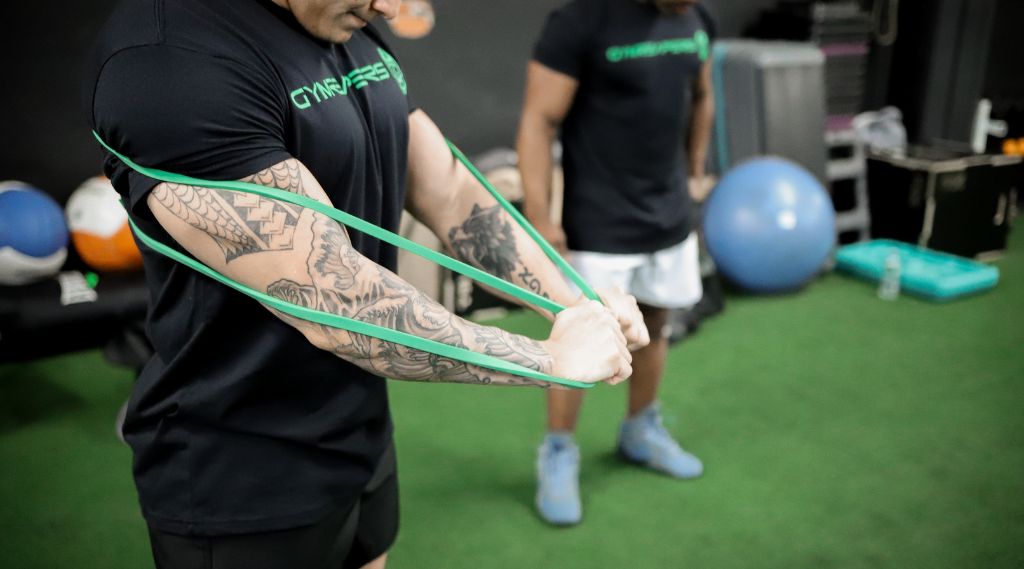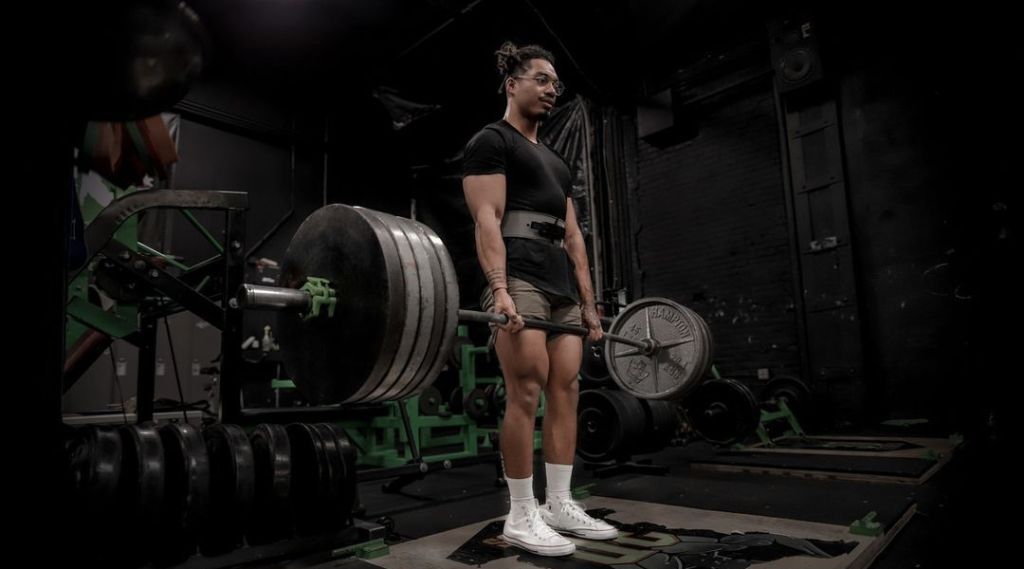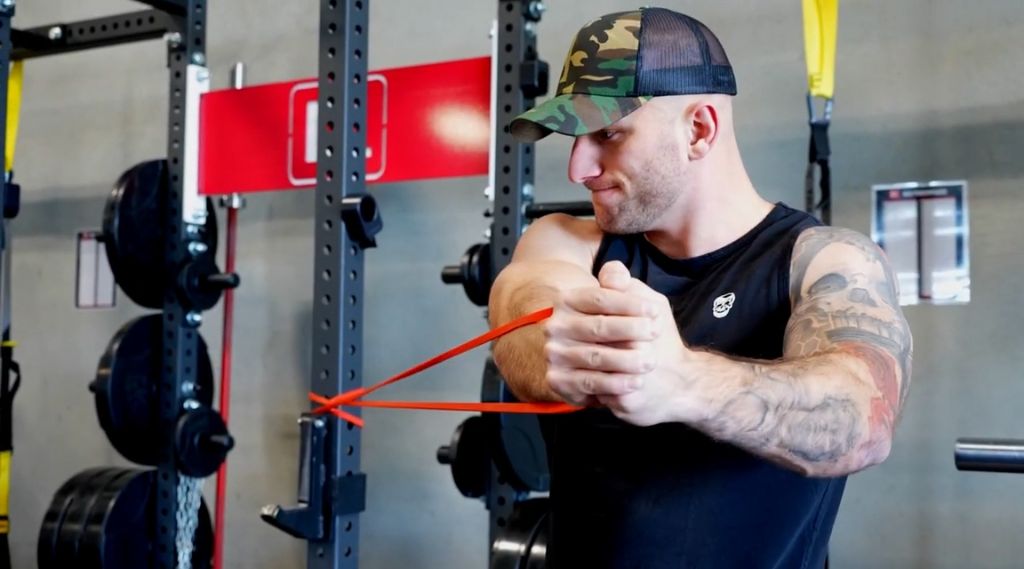If you’re looking to take your chest training to the next level to improve your bench press or build a bigger physique, then incorporating bands into your workout routine is the way to go.
Some of the best resistance band chest exercises include banded bench press, floor press, flyes, pullovers, dips, and incline press.
Adding these exercises into your training and progressively overloading them will lead to greater development of all 3 muscles that make up your chest.
To help you get the most out of banded chest workouts, I'll share 10 of the best exercises to grow and develop your chest, teach you how to perform the movements properly and give you a sample workout that you can start implementing today.
Key Takeaways
- Your chest is composed of 3 main muscles and is primarily responsible for performing horizontal pushing actions and for moving your arm toward and across your torso.
- Training your chest with a resistance band is a great way to warm up, keep constant tension in your muscles, promote more muscle activation, and add more intensity and volume to your training.
- Having a variety of bands at your disposal increases the variety of chest exercises you can perform and allows you to progress over time, which leads to better gains.

Shop recommended Resistance Bands
Anatomy of the Chest Muscles
The chest is a dominant muscle group in your upper body that comprises 3 major muscles. This group of muscles makes up the upper portion of your torso between your ribs and collarbone.
The chest is primarily responsible for:
- Performing pushing actions in a horizontal plane (such as pushups or bench press).
- Adducting the arm by moving your arm toward and across your chest.
The chest muscles include the pectoralis major, the pectoralis minor, and the serratus anterior.
Pectoralis Major
The pectoralis major is the largest of the three muscles in the group. It is a fan-shaped muscle that covers the entire chest. It originates at the clavicle (collarbone), ribs, and sternum and inserts into the upper portion of your humerus, which is your upper arm bone.
This is the muscle that primarily functions to move your arm towards and across your chest. Its development is targeted by doing movements such as cable flys, bench press, and pushups.
Pectoralis Minor
The pectoralis minor is a much smaller muscle that is found underneath the pectoralis major. It attaches around your ribs and reaches to your shoulder blade.
The pectoralis minor’s major function is pulling the shoulder down and forward. Due to its size, it is almost impossible to isolate, but movements such as dips and standing flys (pulling from a high to low position) are great to target your pectoralis minor.
Serratus Anterior
Finally, there is the serratus anterior. While this muscle is not strictly part of the chest anatomy, it is commonly included with this muscle group because it attaches near your pecs on the ribs.
Your serratus anterior’s primary function is to move your shoulder blade forward and upward, and it can be targeted by doing exercises like dumbbell pullovers and ab wheel rollouts.
While traditional pushing movements will help train your chest (things like pushups, cable crossovers, dips, and bench press), you can take your chest training to the next level by targeting the different chest muscles using your knowledge of anatomy.
Later on, I’ll share my top 10 banded chest exercises that work all 3 of these muscles to maximize your training and development.
Benefits of Training the Chest With Bands

Here are five reasons why you should incorporate bands into your chest training:
1) Greater muscle contractions.
One of the best benefits of band exercises comes from linear variable resistance (LVR), which basically means bands offer more resistance as they stretch out and less resistance as they stretch less.
This means that the top portion of your exercises, which are closer to lockout, will be harder than with free weights or cables. So exercises where you would normally rest at the top (like bench press) now deliver constant band tension on your pecs and give them more stimulus (like banded bench press).
2) Challenges your stability.
Training chest movements with resistance bands challenges your muscles’ ability to stabilize the weight. This helps to strengthen your stabilizing muscles, which reduces your risk of injury and improves your ability to lift more challenging weights.
3) Awesome for warming up.
Resistance band movements are a great way to warm up your joints before you start lifting heavier. As you get older, you likely find that your joints take longer to get warmed up for strength workouts.
Bands are a great way to minimize the aches and pains that you may experience when you first get to the gym. They place less overall load and stress on your joints and will help you bring blood flow to the stiff areas.
To learn how to warm up properly and make it as effective as possible, check out this banded warm-up.
4) Great way to add more volume & intensity.
Bands provide a great opportunity to overload your chest muscles and encourage more muscle growth. I love to incorporate bands by doing drop sets and supersets after I have already done a variation of the same exercise with free weights.
For example, I will hit a set of dumbbell flys, and then immediately drop the weights and do a banded version of the same exercise until failure. This is a great way to add volume and intensity to your workouts while still minimizing risks of injury and overtraining.
5) Minimal equipment required.
You can get some great chest workouts using bands, a place to anchor it, and your bodyweight. The convenience of bands makes them great for home workouts or while traveling.
The Versatility of Resistance Bands for Home Chest Workouts
Resistance bands are the perfect tool for home workouts—they’re lightweight, portable, and incredibly versatile. Whether you're focusing on chest exercises or a full-body routine, bands provide all the resistance you need without taking up space or requiring heavy equipment. You can easily adjust the intensity to match your fitness level and target specific muscle groups. Plus, they're ideal for travel or quick sessions at home. Ready to upgrade your home gym? Shop our Gymreapers resistance bands and start building strength wherever you are!
Related Article: Neck Training Exercises With Resistance Bands
10 Best Chest Exercises With Bands
1. Banded Bench Press
A banded bench press involves taking your regular bench press movement and adding a resistance band. It is a great movement that primarily targets your chest muscles, but will also indirectly target your shoulders and triceps, depending on what variation of the movement you do.
How to do Banded Bench Press
- Get two bands of the same tension and wrap each one around one end of the barbell.
- Anchor the other end of each band to a stable point on, or around, the floor. Most frequently, this will be a heavy dumbbell, the bottom of your rack, or pegs that are specifically for anchoring your bands.
- Perform your bench press movement like you normally would. This includes starting with the bar extended above your shoulders, lowering the bar to your chest in a controlled manner, briefly pausing at the bottom, and pushing back up to your start position.
- You should feel almost no band tension near the bottom of the movement, and the most band tension near lockout.
- Do 3-4 sets of 6-10 reps.
Pro tip: Do not anchor the band directly underneath the bar when it is in the rack. This will create unwanted instability and horizontal tension when you perform the movement. Instead, anchor the band so that it will be directly underneath the bar when you are actually bench pressing.
2. Banded Floor Press
If you do not have access to a bench press, you can easily swap out a banded bench press for a banded floor press. This is a great exercise that only requires a band, and will be a great way to isolate your chest while minimizing stress on your shoulders.
How to do Banded Floor Press
- Hold the ends of the band in the palms of your hands.
- Have the band stretched behind your back, still having it in the palms of your hands. Make sure to have the band running across your upper back but underneath your shoulders.
- Lie down on the floor. The band should be underneath your body, pinned between your back and the floor.
- As you’re laying down, have the back parts of your arms (triceps) flat against the floor with your elbows bent at about 90 degrees. This is your starting position.
- Keeping the band secure in your hands, press up and away from the floor like you would in a dumbbell bench press.
- Return to your start position in a slow and controlled manner.
- Do 4 sets of 15-20 reps.
Pro tip: Bring your hands together at the top of the movement and pause briefly. This will create a lot of tension and really maximize the squeeze in your chest muscles.
3. Banded Push-Ups
This variant of a classic pushup is done by placing a resistance band around your back and performing pushups. It is a great way to increase muscle activation in your chest and triceps.
This is a great exercise option for those who can do a ton of bodyweight push-ups because it makes them more challenging and reduces the number of reps you can do. It also helps you develop explosive pressing power.
How to do Banded Push-Ups
- Hold the band in your hands and wrap it around your back as if you are doing a banded floor press (explained above).
- Instead of lying down on your back, assume a pushup position. The band should be trapped between your palms and the floor.
- Get into the normal start position of a pushup. Be sure to have the band running along your upper back and tracking down the outside of your arms.
- Perform your pushups like normal. They should be easiest near the ground, and most difficult near lockout.
- Perform 4 sets of 8-12 reps.
Pro tip: Immediately after your last set of banded push-ups, remove the band and do as many reps as possible with just your bodyweight for a burnout set.
4. Banded Flys
This classic single-joint movement is great for isolating the chest muscles. There are plenty of variations of this movement that change the way your chest is targeted, based on where you attach the cables.
For example, if you anchor the band higher and finish your fly in a low position near your waist, you will target more of your pectoralis minor. If you anchor the band low and finish your fly in a higher position, you will target more of the lower fibers of your pec major.
How to do Banded Flys
- Find a study anchor point for your band. I typically recommend a pole or part of a power rack, but anything should work as long as it is secure.
- Wrap your band around your pole or another stable anchor point.
- To start, have the band anchored at about chest level. Later, you can experiment with higher or lower anchor points to change the muscle stimulus.
- Stand a few paces in front of your anchor point, with your back facing it. The band should be in your palms and should be tautly stretched between you and the anchor point behind you. Your feet should be staggered, and you should have a slight forward lean. This is your starting position.
- Starting with your hands out wide to your side, bring your hands together in a controlled motion. To make sure you are feeling the squeeze in your pecs, keep your shoulder blades depressed (down) and keep your arms fairly straight.
- Pause for a second with your hands together and your chest squeezed, then return to your start position.
- Perform 3-4 sets of 10-15 reps.
Pro tip: Regardless of the variation, make sure to keep the scapula retracted (squeezed together) and depressed down your back to keep your front delts from taking over.
5. Banded Pullovers
This exercise is great for targeting your serratus anterior, while also developing the rest of your chest. The classic dumbbell pullover has long been used for chest gains, and in my opinion, the banded pullover levels up the intensity and tension that this classic exercise can give.
How to do Banded Pullovers
- To start, you will need a stable anchor point (like in the banded flys) and a bench or other elevated surface to lay down on.
- Anchor your band to the pole or rack in a very low position, only slightly above the ground.
- Place your bench far enough away from the anchor point so that the band is taut when stretched to reach the bench.
- Lay down on the bench with your head closest to the anchor point.
- Hold the band in both of your hands straight above your chest and shoulders. The band should be pulling back over your head, towards the anchor point.
- Slowly let the band pull back over your head. Keep your elbows straight and try to focus the squeeze in your lats, chest, and serratus.
- Pause once your hands have been pulled by the band so far that they are in line with, or slightly behind, your head. The band should still be taut.
- Initiate the pull back up to the start position. Keep the tension in your chest by keeping your arms straight and your back tight.
- Perform 3 sets of 15-20 reps.
Pro tip: Do not try and move too quickly in this exercise. Keeping a slow, steady, and controlled pace will ensure you activate your chest and will keep your lats and triceps out of the movement.
6. Standing Incline Chest Press
This is a great exercise variation of the traditional incline bench press. This exercise can be done with minimal equipment (only a band required!) and feels much better on the shoulders than some barbell and dumbbell variations.
By changing the angle from low to high, you can put more emphasis on the upper chest and front of the shoulders.
How to do Standing Incline Chest Press
- To anchor the band, I would first try to use the exact same setup as the banded pullovers (outlined above) and then stand with your back to the band in a staggered stance.
- If this will not work, either because you don't have an anchor point or you feel like the band will slide upwards, you can plant your feet in a staggered stance and anchor the band underneath your back foot.
- Hold the ends of the band in both hands and start with your hands up near your chest. The bands should already be slightly taut, with no slack.
- Push diagonally upward and bring your hands close together to maximize the squeeze on your chest.
- Pause in the squeeze position, then slowly return to the start position and go again.
- Perform 4 sets of 15-20 reps.
Pro tip: Since this movement reinforces core and anti-rotational strength with the staggered stance, make sure to do an equal number of sets and reps with each leg forward.
7. Banded Dips (Assisted Variation)
Traditional dips are a great way to grow your chest and develop its strength; however, not everyone can do sets of dips with their body weight.
Band-assisted dips are a great way to still reap the benefits of this movement and are a great tool to work your way to doing bodyweight or even weighted dips.
How to do Banded Dips (Assisted Variation)
- Wrap one end of a looped resistance band over one side of the dip handles, and then wrap the other end around the other handle.
- You should now have a semi-saddle of the band between the dip handles. The thicker the band is, the more it will help you during your dips.
- Place your hands on the handles like normal, and put both of your knees on the band-saddle.
- You should now feel the band supporting you as you are suspended by your hands with your triceps locked. This is your starting position.
- Take a deep breath, retract your shoulders, and start bending your elbows. This will lower your body.
- Once your elbows have bent to 90 degrees, or as far as is comfortable, push yourself back up to your start position.
- Pause at the top, squeeze your triceps, breathe out, and get ready for another rep.
Pro Tip: Make sure you come all the way up and lock out your triceps at the top of each rep. If you’re struggling to lock out, then choose a heavier band that provides more assistance.
8. Banded Decline Press
Wrapping up our pressing exercises, the banded decline press is a great movement to ensure total activation of all of your chest muscles.
Decline pressing is a great way to target your pectoralis major, and is usually a stronger position to press from, so you may be able to load your muscles with more resistance.
How to do Banded Decline Press
- Anchor your band to a much higher point than your incline press. Typically, I recommend anchoring no lower than the height of your head.
- Adopt the same body and hand position as you did when performing your banded flys or incline press. This includes the staggered foot position.
- This time, instead of pressing up, you will press down diagonally. Finish the movement with a slight pause and your hands close together before returning to your start position.
- Perform 4 sets of 15-20 reps.
Pro tip: Similar to the tip on the banded incline press, make sure to do an equal number of sets and reps with each foot forward to ensure that you avoid imbalances. Additionally, make sure you’re pressing the bands rather than performing the movement like a “fly”.
9. Banded Single-Arm Prone Punches
This exercise is great for targeting your upper chest, primarily your pectoralis minor. It mimics an incline dumbbell press, except it takes place on the floor and only requires a band and an anchor point.
How to do Banded Single-Arm Prone Punches
- Anchor your band very low on a pole or rack. It should be no more than 12 inches off the ground.
- Lie face down on the ground. The anchor point should be to the side and behind you.
- Grab the band with your hand on the side where you are working. You can support yourself with your other arm by propping yourself up on your elbow.
- Start with the band taut in the working arm and your hand at your shoulder.
- Press straight out just above the floor to full extension.
- Keeping your palm facing the ground the entire time, pause at the top and slowly lower back to start.
- Do 3 sets of 10-12 reps per arm.
Pro tip: Your arm should never be touching the ground. Keep it low to maintain an angle of push that you would experience with a traditional incline press. This may mean propping yourself up more with your non-working hand to activate more chest and less shoulder.
10. Banded Single-Arm Saw
This final exercise is a powerful band exercise that will give you an amazing chest contraction, and it only requires a band and an anchor point. It gets its name from the back-and-forth sawing motion across your chest, and it mimics a banded crossover. The difference is that, unlike the crossover, the saw keeps your arm close to your chest.
How to do Banded Single-Arm Saw
- Anchor the band to a point that is about chest height.
- Your starting position is standing with your feet flat on the floor, no staggering, and facing perpendicular to your anchor point (one shoulder pointing at it).
- Grab the band with your arm that is closest to the band and the anchor point. Loop your hand inside the band and keep your elbow locked at your side. The band should be taut.
- Plant your feet firmly, and use the heel of your hand to drive your arm across your chest away from the anchor point. Keep the band and your hand chest level.
- Maintain your core rightness the entire time, try not to swivel your feet, and keep your hand, arm, and the band as close to your torso as you can.
- Pause for a brief moment near the top of the rep, and then slowly return back to start.
Pro tip: This should feel more like a press than a fly or crossover. If it helps to keep your core stable and reduce twisting, you can place your non-working hand on your hip.
Sample Chest Workout Routine With Bands
Now that you’re familiar with the best exercises, it’s to time combine them into a program, here is an effective resistance band chest routine that you can do with some of the above exercises:
|
Exercise |
Sets |
Reps |
Rest |
Notes |
|
Banded Bench Press |
3-4 |
6-10 |
180 seconds |
These should be fairly heavy and challenging |
|
Band-Assisted Dips |
3-4 |
6-8 |
120-180 seconds |
If you can do regular dips for 3 sets of 12-15, switch this to band-resisted dips. |
|
Banded Flyes |
4 |
15 |
60-90 seconds |
Straight flyes, no diagonal angles. |
|
Banded Pullovers |
3 |
15-20 |
60 seconds |
Slow and controlled |
|
Banded Push Ups |
4 |
8-12 |
90-120 seconds |
After your 4th set, ditch the band and do an AMRAP set. |
Note that I did not include all 10 exercises. This is because some of them are very similar and target the chest in the same manner. It would be redundant to perform all of them on the same day, and they are better viewed as options that you can swap in and out depending on your training preferences.
Best Bands For Training Your Chest
When looking to incorporate banded exercises into your chest training, I highly recommend purchasing multiple bands so that you have different levels of resistance to choose from.
This will be the best way to make sure you are properly equipped as you get stronger, and allow you to perform a variety of movements that require different levels of resistance.

The Gymreapers Military Resistance Band Set is a great full set of resistance bands. The set comes with bands that range in resistance from 20-150 lbs to satisfy every need possible for adding banded training exercises into your program. If you do not want a full resistance band set, you can buy the bands individually.













1 comment
KENNETH CONNOR
is there any were in the Uk that stock s your merchandise
Leave a comment
All comments are moderated before being published.
This site is protected by hCaptcha and the hCaptcha Privacy Policy and Terms of Service apply.